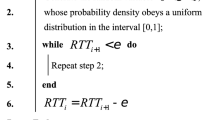Abstract
P2P-TV systems will certainly contribute to innovate the broadcast TV concept by allowing ubiquitous access to a practically unlimited number of channels, representing an important step forward in the direction of the Anything/Anyone/Anywhere/Anytime communication paradigm of future Internet applications. Since its deployment, P2P-TV has already attracted millions of users and it is expected to grow exponentially in the near future, both in terms of the number and diversity of their clients. Analyzing the behavior of P2P-TV systems and users and characterizing the generated traffic are fundamental steps to understand and evaluate the potential impacts of these applications on the underlying transport network. In this paper, a set of intensive measurements was conducted in a residential Internet access environment in order to obtain a good insight over the mechanisms that govern data transfer on some of the most important P2P-TV applications (TVants, SOPCast and TVU Player) and understand the most important advances they have suffered in the latest years. Among other relevant findings, the analysis showed that peer location does not seem to be exploited by any of the studied applications and P2P-TV is already a worldwide phenomenon: using the three selected applications during 12 days of experiments, peers from 177 different countries all over the world were contacted, including countries where the interest for English-spoken channels was not so likely.
















Similar content being viewed by others
Explore related subjects
Discover the latest articles, news and stories from top researchers in related subjects.References
Babelgum (2009). http://www.babelgum.com.
Joost (2009). http://www.joost.com.
PP live (2009). http://www.pplive.com.
Soapcast (2009). http://www.sopcast.org.
TVAnts (2009). http://www.TVants.com.
TVU player (2009). http://www.tvunetworks.com.
Wireshark (2009). http://www.wireshark.org.
Zattoo (2009). http://www.zattoo.com.
Agarwal, S. (2007). A case study of large scale P2P video multicast. In Proceedings of the international conference on IP multimedia subsystem architecture and applications.
Agarwal, S., Singh, J. P., Mavlankar, A., Baccichet, P., & Girod, B. (2008). Performance and quality-of-service analysis of a live P2P videomulticast session on the Internet. In Proceedings of the 16th international workshop on quality of service.
Alessandria, E., Gallo, M., Leonardi, E., Mellia, M., & Meo, M. (2009). P2P-TV systems under adverse network conditions: a measurement study. In Proceedings of the IEEE GLOBECOM 2009.
Ali, S., Mathur, A., & Zhang, H. (2006). Measurements of commercial peer-to-peer live video streaming. In Proceedings of the workshop on recent advances in peer-to-peer streaming.
Argyriou, A. (2005). A novel end-to-end architecture for H.264 video streaming over the Internet. Telecommunications Systems, 28, 133–150. doi:10.1007/s11235-004-5013-1.
Basher, N., Mahanti, A., Mahanti, A., Williamson, C., & Arlitt, M. (2008). A comparative analysis of web and peer-to-peer traffic. In Proceedings of the 17th world wide web conference, Beijing.
Ciullo, D., Meo, M., & Leonardi, E. (2008). Understanding P2P-TV systems through real measurements. In Proceedings of the IEEE GLOBECOM 2008.
Ciullo, D., Garcia, M. A., Horvath, A., Leonardi, E., Mellia, M., Rossi, D., Telek, M., & Veglia, P. (2008). Dissecting pplive, sopcast, tvants (technical report). Politecnico di Torino.
Fu, X., Lei, J., & Shi, L. (2007). An experimental analysis of joost peer-to-peer voD service (technical report ifi-tb-2007-03). Institute for Computer Science, University of Gottingen.
Wang, F., Liu, J., & Xiong, Y. (2008). Stable peers: existence, importance, and application in peer-to-peer live video streaming. In Proceedings of the IEEE infocom.
Gardikis, G., Xilouris, G., Pallis, E., & Kourtis, A. (2010). Joint assessment of network and perceived-QoS in video delivery networks. Telecommunications Systems. doi:10.1007/s11235-010-9354-7.
Hall, Y., Piemonte, P., & Weyant, M. (2007). Joost: A measurement study (technical report). Carnegie Mellon University.
Hei, X., Liang, C., Liang, J., Liu, Y., & Ross, K. (2007). A measurement study of a large-scale P2P IPTV system. IEEE Transactions on Multimedia, 9, 1672.
Hei, X., Liu, Y., & Ross, K. Inferring network-wide quality in P2P live streaming systems. IEEE Journal on Selected Areas in Communications—special issue on P2P Streaming, 25(9).
Hei, X., Liu, Y., & Ross, K. IPTV over P2P streaming networks: the mesh-pull approach. IEEE Communications Magazine, 46(2).
Krieger, U., & Schwessinger, R. (2008). Analysis and quality assessment of peer-to-peer IPTV systems. In Proceedings of the IEEE international symposium on consumer electronics, Vilamoura.
Magharei, N., Rejaie, R., & Guo, Y. (2007). Mesh or multiple-tree: a comparative study of live P2P streaming approaches. In Proceedings of the IEEE Infocom.
Silverston, T., & Fourmaux, O. (2006). P2P IPTV measurement: a comparison study.
Silverston, T., & Fourmaux, O. (2007). Measuring P2P IPTV systems. In Proceedings of the ACM NOSSDAV’07.
Vu, L., Gupta, I., Liang, J., & Nahrstedt, K. (2007). Measurement of a large-scale overlay for multimedia streaming. In Proceedings of the 16th international symposium on high performance distributed computing.
Wamser, F., Pries, R., Staehle, D., Heck, K., & Tran-Gia, P. (2011). Traffic characterization of a residential wireless Internet access. Telecommunications Systems, 48, 5–17. doi:10.1007/s11235-010-9324-0.
Author information
Authors and Affiliations
Corresponding author
Rights and permissions
About this article
Cite this article
Salvador, P., Nogueira, A., Mendes, J. et al. Statistical characterization of P2P-TV services and users. Telecommun Syst 55, 363–376 (2014). https://doi.org/10.1007/s11235-013-9793-z
Published:
Issue Date:
DOI: https://doi.org/10.1007/s11235-013-9793-z




